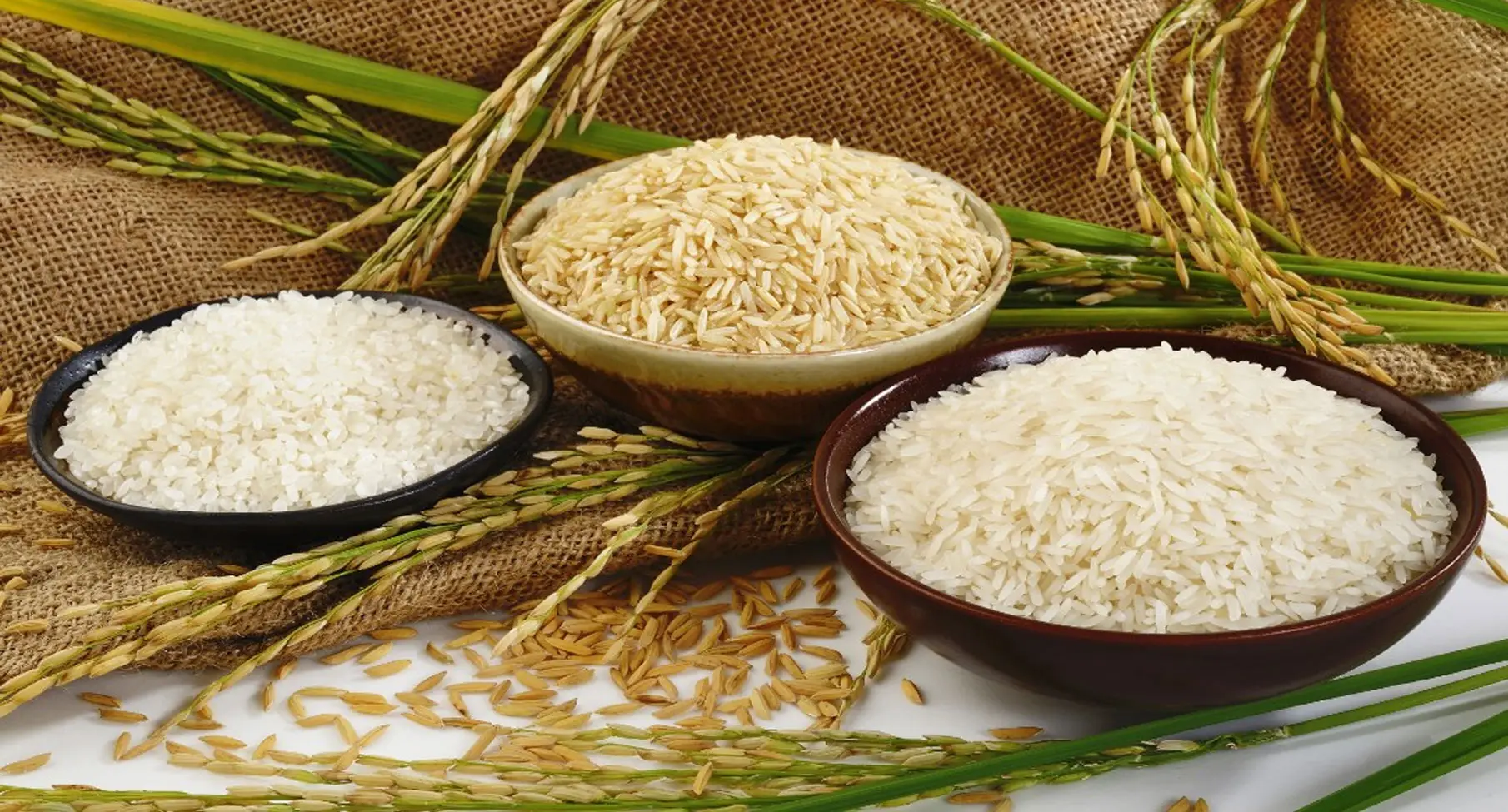Basmati Rice – Aroma, Quality & Health Benefits
Basmati rice is a long-grain, aromatic rice variety native to the Indian subcontinent. Known for its unique fragrance, fluffy texture, and slender grains, it is prized in culinary traditions worldwide. “Basmati” means “fragrant” in Hindi, and it truly lives up to the name. It’s a staple in biryani, pulao, and special-occasion meals.
- Basmati Rice – Aroma, Quality & Health Benefits
- Origin and History
- Key Characteristics of Basmati Rice
- Types of Basmati Rice
- Health Benefits of Basmati Rice
- Why Basmati is Preferred Over Regular Rice
- Cooking Tips for Perfect Basmati Rice
- Popular Dishes Made with Basmati Rice
- Storage and Shelf Life
- Basmati Rice in Global Trade
- Environmental Impact and Sustainability
- FAQs
- Conclusion
Unlike ordinary rice, it elongates rather than thickens when cooked. Its premium quality, taste, and aroma make it one of the most exported rice types globally. Basmati rice is available in both white and brown forms, offering variety for different preferences and recipes.
Origin and History
Basmati rice has been grown in the Himalayan foothills for centuries. Its history dates back to ancient times in India and Pakistan, where it was considered a royal grain. Over generations, farmers cultivated its unique traits — length, aroma, and taste. It is mentioned in traditional Indian and Mughal cuisine, often served during grand feasts.
Today, Pakistan and India are the largest producers and exporters of Basmati rice. Its international popularity surged in the 20th century, especially in Middle Eastern, European, and American markets. Basmati remains a cultural symbol of premium quality and hospitality in South Asia.
Key Characteristics of Basmati Rice
Basmati rice is famous for its long, slender grains that can expand up to twice their size during cooking. Its most notable trait is its distinct aroma, often compared to popcorn or pandan leaves. The grains remain separate, fluffy, and non-sticky, making them ideal for dishes like biryani.
It has a low glycemic index, is gluten-free, and contains essential nutrients such as magnesium, potassium, and B vitamins. Basmati rice is often aged for better taste and texture, enhancing its cooking quality and flavor. Its delicate yet firm texture makes it a global favorite.
Types of Basmati Rice
There are several types of Basmati rice, each suited for different uses:
- Traditional Basmati: Naturally grown and aged, with intense aroma and flavor.
- 1121 Extra Long Grain: The longest Basmati grain variety, ideal for biryani.
- Pusa Basmati: Hybrid variety known for high yield and good quality.
- Brown Basmati: Whole grain version with more fiber and nutrients.
Each type offers unique cooking characteristics. While traditional Basmati is best for authentic dishes, brown Basmati is preferred for health-conscious diets. Buyers often choose based on grain length, aroma strength, and intended use.
Health Benefits of Basmati Rice
Basmati rice is not only delicious but also healthy. Its low glycemic index makes it suitable for people managing blood sugar levels. It’s rich in fiber, especially in the brown variant, which supports digestion and heart health. Basmati contains fewer calories and carbs compared to most long-grain rice types. It’s gluten-free and easy to digest, making it ideal for people with gluten intolerance or sensitive stomachs.
Packed with B vitamins, iron, and essential amino acids, Basmati supports energy, metabolism, and muscle function. When cooked without excess oil or fat, it becomes a highly nutritious part of any meal.
Why Basmati is Preferred Over Regular Rice
What sets Basmati apart from regular rice is its aroma, elongation, and fluffiness. Unlike sticky or short-grain rice, Basmati maintains its grain structure after cooking. It has a lower starch content, resulting in less stickiness and more volume.
The aging process also enhances its texture and flavor. In comparison to regular white rice, Basmati offers better taste, higher digestibility, and more versatility. Whether you’re preparing a quick pulao or a festive biryani, Basmati gives a luxurious feel and superior presentation. For those who value quality and authenticity, Basmati is always the first choice.
Cooking Tips for Perfect Basmati Rice
To cook perfect Basmati rice:
- Rinse the rice thoroughly to remove surface starch.
- Soak for 20–30 minutes before cooking to allow grains to expand fully.
- Use a 1:1.5 to 1:2 rice-to-water ratio.
- Cook on low heat and avoid stirring too much.
- Let it rest covered after cooking for 5–10 minutes.
These steps help preserve the integrity of the grains and enhance aroma. Avoid overcooking or excessive stirring, which can break the grains. Aged Basmati requires slightly more water and cooking time.
Popular Dishes Made with Basmati Rice
Basmati rice is the heart of many traditional and international recipes:
- Biryani – Layered rice with spices and meat or vegetables.
- Pulao – Flavored rice with peas, nuts, or meat.
- Jeera Rice – Cumin-flavored simple rice dish.
- Fried Rice – Asian-style stir-fried version.
- Rice Bowls – With grilled chicken, beans, or veggies.
Its versatility makes it suitable for fine dining as well as daily meals. Even in international cuisines, Basmati is replacing regular long-grain rice due to its superior quality and appeal.
Storage and Shelf Life
Basmati rice, especially aged varieties, has a long shelf life of up to 12–24 months when stored properly. It should be kept in a cool, dry place away from direct sunlight and moisture. Airtight containers help retain aroma and prevent pest infestation. Do not store it near strong-smelling spices or cleaning products, as rice can absorb odors.
Proper storage also maintains the texture and flavor of the grains over time. For commercial purposes, Basmati rice is available in vacuum packs or jute bags to ensure freshness during transport and storage.
Basmati Rice in Global Trade
Basmati rice plays a major role in global food trade. Pakistan and India are its largest exporters, supplying to countries like the UK, UAE, Saudi Arabia, USA, and Canada. It is in high demand due to cultural preferences, health awareness, and restaurant use. Export-quality Basmati is rigorously tested for grain length, moisture, aroma, and purity.
With rising demand for clean-label, non-GMO food, Basmati has established itself as a premium export product. Governments and private companies invest in its quality control, branding, and certifications to meet global standards and consumer trust.
Environmental Impact and Sustainability
Modern Basmati farming focuses on sustainability. Farmers are trained in water conservation, pesticide control, and organic techniques. Compared to other rice varieties, Basmati is less water-intensive. It also requires fewer chemical inputs, especially in organic farming practices. Many Basmati brands now offer eco-labeled or certified organic options for environmentally conscious consumers.
Efforts are being made to reduce the carbon footprint in processing and packaging. By supporting sustainable farming, Basmati buyers help preserve soil quality, biodiversity, and local farming communities.
FAQs
how to cook basmati rice?
Rinse basmati rice, soak 30 minutes, boil water, add rice, simmer covered 15 minutes, rest 5 minutes, then fluff.
is basmati rice healthy
Yes, basmati rice is healthy. It’s low in fat, gluten-free, and provides essential nutrients like carbs, fiber, and B vitamins.
what is basmati rice
Basmati rice is a long-grain, aromatic rice grown mainly in India and Pakistan, known for its fluffy texture and fragrance.
is basmati rice gluten free
Yes, basmati rice is naturally gluten-free, making it a safe and healthy choice for people with gluten intolerance or celiac disease.
how to cook brown basmati rice
Rinse brown basmati rice, soak 30 minutes, boil water (2.5 cups per cup of rice), simmer covered 35–40 minutes, then fluff.
how to cook basmati rice in rice cooker
Rinse basmati rice, add to rice cooker with 1.5 cups water per cup of rice, close lid, and cook on white rice setting.
Conclusion
Basmati rice is more than just a grain — it’s a symbol of tradition, nutrition, and quality. Its unique aroma, long grains, and health benefits make it a favorite across the world. From royal feasts to everyday meals, it enhances the dining experience with its elegance and flavor. For those seeking premium, export-quality Basmati rice, aatradeco.com offers trusted solutions with unmatched standards and consistency.




Leave a Reply